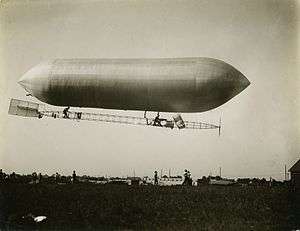Signal Corps Dirigible No. 1
| Signal Corps Dirigible No. 1 | |
|---|---|
 | |
| Role | Dirigible |
| National origin | United States |
| Designer | Thomas Scott Baldwin |
| Number built | 1 |
| Unit cost |
$5,737.50 in 1908 |
Signal Corps Dirigible No. 1 was the first powered aircraft ordered for the Signal Corps by the Aeronautical Division of the United States Army. The purchase of SC-1, a dirigible designed by Thomas Scott Baldwin, was the result of urgings by Chief Signal Officer Brigadier General James Allen. After seeing Baldwin demonstrate a dirigible at the St. Louis air meet in 1907, Allen had urged the U.S. Army to buy a dirigible, as many European armies had dirigibles by the turn of the century.[1]
On 5 August 1908, the Army tested SC-1 at Fort Myer, Virginia. The craft fell short of a 2-hour, 20 mph objective to meet a $8,000 per unit award. The Army formally accepted the craft as Signal Corps Dirigible No. 1 paying $5,737.50.[2] On 28 Aug. 1908 Lieutenants Frank Lahm, Thomas Selfridge and Benjamin Foulois were taught to fly the craft.[1]
After Second Lieutenant John G Winter Jr of the 6th Cavalry was assigned to duty in the Aeronautical Division, the balloon detachment was transferred to Fort Omaha, Nebraska.[3]
On 26 May, pilot Lieutenant Lahm and Lieutenant Foulois made a flight in SC-1 at Fort Omaha, and manoeuvred the craft at will. SC-1 remained there until scrapped in 1912. The Army did not purchase another dirigible until after World War I.[1]
Specifications (Signal Corps Dirigible No. 1)
Data from Smithsonian
General characteristics
- Capacity: 1
- Length: 93 ft (28 m)
- Volume: 20,000 cu ft (570 m3)
- Useful lift: 1,360 lb (620 kg)
- Powerplant: 1 × Curtiss , 20 hp (15 kW)
Performance
- Maximum speed: 17 kn; 32 km/h (19.61 mph)
- Cruise speed: 12 kn; 22 km/h (13.75 mph)
References
- 1 2 3 Baldwin Dirigible: U.S. Army\'s First Airship. National Museum of the United States Air Force. 22 May 2010. URL:http://www.nationalmuseum.af.mil/factsheets/factsheet.asp?id=665. Accessed: 2010-05-22. (Archived by WebCite at http://www.webcitation.org/5pvYz7arq)
- ↑ Tom D. Crouch. "Aero Club of Washington: Aviation in the Nation's Capital, 1909-1914": 39.
- ↑ "Army News: Dirigible No 1", Aeronautics; Volume 5, Number 1, p. 10, July 1909